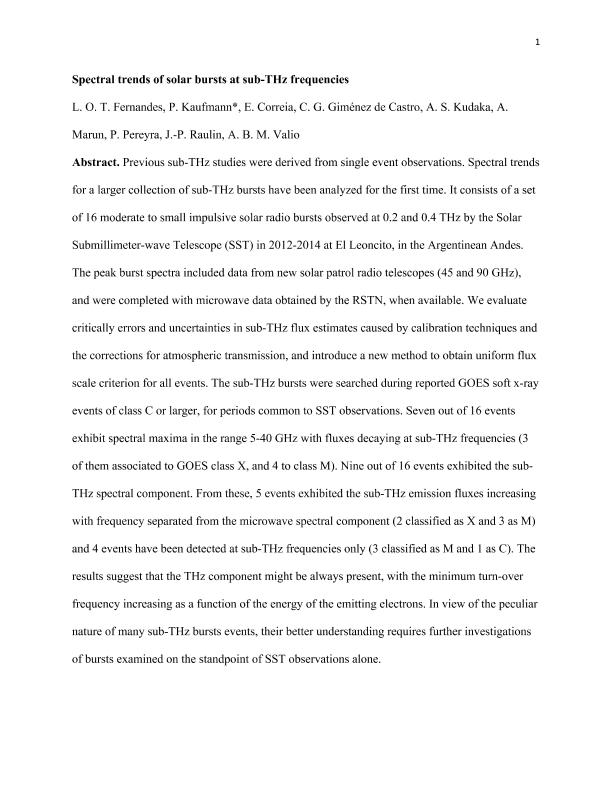Artículo
Spectral Trends of Solar Bursts at Sub-THz Frequencies
Fernandes, L. O. T.; Kaufmann, Pierre; Correia, E.; Giménez de Castro, C. G.; Kudaka, A. S.; Marun, Adolfo Hector ; Pereyra, Pablo Florencio
; Pereyra, Pablo Florencio ; Raulin, J. P.; Valio, A. B. M.
; Raulin, J. P.; Valio, A. B. M.
 ; Pereyra, Pablo Florencio
; Pereyra, Pablo Florencio ; Raulin, J. P.; Valio, A. B. M.
; Raulin, J. P.; Valio, A. B. M.
Fecha de publicación:
01/2017
Editorial:
Springer
Revista:
Solar Physics
ISSN:
0038-0938
e-ISSN:
1573-093X
Idioma:
Inglés
Tipo de recurso:
Artículo publicado
Clasificación temática:
Resumen
Previous sub-THz studies were derived from single-event observations. We here analyze for the first time spectral trends for a larger collection of sub-THz bursts. The collection consists of a set of 16 moderate to small impulsive solar radio bursts observed at 0.2 and 0.4 THz by the Solar Submillimeter-wave Telescope (SST) in 2012 – 2014 at El Leoncito, in the Argentinean Andes. The peak burst spectra included data from new solar patrol radio telescopes (45 and 90 GHz), and were completed with microwave data obtained by the Radio Solar Telescope Network, when available. We critically evaluate errors and uncertainties in sub-THz flux estimates caused by calibration techniques and the corrections for atmospheric transmission, and introduce a new method to obtain a uniform flux scale criterion for all events. The sub-THz bursts were searched during reported GOES soft X-ray events of class C or larger, for periods common to SST observations. Seven out of 16 events exhibit spectral maxima in the range 5 – 40 GHz with fluxes decaying at sub-THz frequencies (three of them associated to GOES class X, and four to class M). Nine out of 16 events exhibited the sub-THz spectral component. In five of these events, the sub-THz emission fluxes increased with a separate frequency from that of the microwave spectral component (two classified as X and three as M), and four events have only been detected at sub-THz frequencies (three classified as M and one as C). The results suggest that the THz component might be present throughout, with the minimum turnover frequency increasing as a function of the energy of the emitting electrons. The peculiar nature of many sub-THz burst events requires further investigations of bursts that are examined from SST observations alone to better understand these phenomena.
Archivos asociados
Licencia
Identificadores
Colecciones
Articulos(CASLEO)
Articulos de COMPLEJO ASTRONOMICO "EL LEONCITO"
Articulos de COMPLEJO ASTRONOMICO "EL LEONCITO"
Articulos(ICATE)
Articulos de INST.D/CS ASTRONOMICAS D/LA TIERRA Y DEL ESPACIO
Articulos de INST.D/CS ASTRONOMICAS D/LA TIERRA Y DEL ESPACIO
Citación
Fernandes, L. O. T.; Kaufmann, Pierre; Correia, E.; Giménez de Castro, C. G.; Kudaka, A. S.; et al.; Spectral Trends of Solar Bursts at Sub-THz Frequencies; Springer; Solar Physics; 292; 1; 1-2017; 1-15
Compartir
Altmétricas



